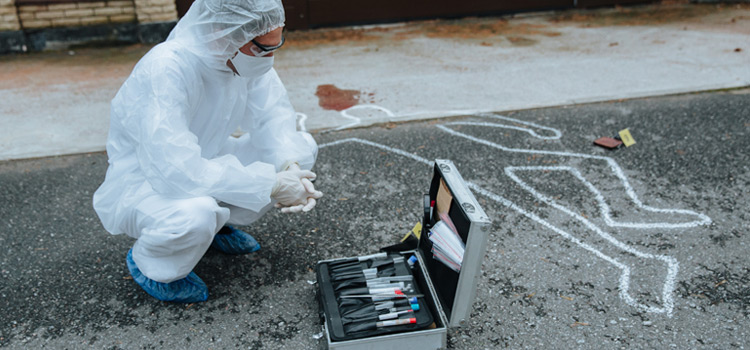Crime Scene and Basic Principles of Forensic Science
Posted On : November 29, 2022

Table of Contents
How do you prove your point in the court of law? Is it the word of the mouth which serves the basis of the judge's decision? Everyone knows that there are some factual aspects of common sense, which hold evidentiary value in the court of law, if they prove a legal or factual point. The difference between civil and criminal law is that civil one mainly requires parties to prove their point. Although, there is no hard and fast rule that restricts court’s assistance at any point. But in criminal cases, especially the serious crimes, police officials play a key role. The criminal justice system seems crude in the absence of police. Since crimes are said to be committed against the state, not an individual. Hence, investigating agencies search for evidence related to a crime to find out the perpetrator and help uphold the sanctity of the justice system in India.
In India, the Code of Criminal Procedure paves the way for how a criminal case proceeds in the court of law. The Evidence Act categorizes the evidence acceptable in the court of law, based on whether it is direct or circumstantial. But the nature of evidence varies in each and every case. Hence, the judge’s understanding of the scientific and technical value of evidence is paramount. But before that, the investigating agencies need to be more aware regarding the forensic evidence present at the crime scenes. If a crucial evidence is ignored by the investigators, it will never reach the courts, ultimately resulting in the miscarriage of justice.
The blog below clarifies seven critical principles of forensic science with examples. Respecting the legal developments and law in India in the 21 century, keeping up with the technological developments becomes all the way more important for empowering the justice system in India.
7 Principles of Forensic Science
Law of Individuality
Nature gives individuality to everything, whether it is natural or man made. What may seem correct to the naked eye at first glance may not be the ultimate truth. The principle is attributed to Paul L Kirk (1963) and regarded as the building block for forensic chemistry. It is explained as “Individuality implies that every entity, whether person or object, can only be identical to itself and so is unique”.
For example, a white powder might otherwise be taken as table salt or sand particles. But the same powder at the crime scene comes under the radar for intoxicating drugs. The law of individuality regards the specific characteristics of such material and helps in identification.
Principle of Comparison
The basic principle of forensic science completely relies upon the mere rule that “Only the likes can be compared”. Like samples should be referred to comparison for the purposes of confirmation. In case it is a blood sample from the crime scene, it has to be clinically compared whether it belongs to a human or any other organism. If there is some close proximity among the accused or the victim, their DNAs can be compared to get a confirmation.
To understand the concept of comparison in a better way, another example may pave the way. If the investigating agency finds traces of skin in the victim’s nails who suffered some kind of abuse or assault, the sample skin might belong to the perpetrator. In such a case, scientifically comparing the DNA of sample skin with that of the accused person may bring some clarity. Similarly, cyber crimes lawyer may help identify cyber criminals with the style of chats and prove it as strong evidence in the courtroom.
Law of Circumstantial Facts
There is a popular statement that “Facts cannot be wrong, they cannot lie, and can not be wholly absent. But men can, and do.” When it comes to statements given by the accused persons, or witnesses, or even the victims, might be a lie. The actual facts might be guarded for personal interests. But the circumstances may not lie confirming with the people’s statements.
Corroboration of facts of the case with the help of circumstantial evidence is the ultimate task during the 27 stages of criminal cases.
Let’s understand this basic principle of forensic science with an example. Suppose the accused brings before the court a plea of alibi stating that he/ she was not present at the crime scene, supposedly at Kolkata, but at some other place. To confirm with his/ her statements, documentary evidence is also attached. But if someone among the witnesses of crime purports his/ her presence and the person’s location history also confirms, it becomes an integral circumstantial fact. The criminal lawyer in Kolkata of the opposite counsel will surely point this out, only if sufficient evidence is available.
In this scenario, the accused may lie regarding his/ her presence, the document produced might also be forged. But the phone’s location might be defective only if the person’s mobile phone was stolen and put at the crime scene deliberately. The burden of proof again lies with the accused who may rely on initiation of police complaint process for lost cell phone.
Law of Probability
We all have feared the chapter of probability while studying Mathematics in school. From calculating the probability of six in a dice, to suspecting the probability of facts around us, we all grew up. The essence lies with the chances of occurrence of something. The occurrence is identified based on the forensic application of probabilistic inference and reasoning.
Taking assistance of an example, the chances of someone onboard travelling from Delhi to Mumbai at a particular time, committing a crime like murder in Punjab are null. On the other hand, the same person onboard with an active internet connection has a higher probability to commit one of the types of cyber crime at any place, if proved with other evidence.
Principle of Exchange
Give and take relationships are not always planned but eventual as well. The principle of exchange in forensic science relies upon this natural phenomenon enunciated by the French Scientist - Edmond Locard. It states that “Whenever two entities come in contact with each other, they exchange the traces between them.”
For example, if someone is murdered whereby knife is the weapon, the injuries borne by the victim will reflect traces of a sharp weapon. On the other hand, the weapon actually used will have blood on it. Hence, if a bloody knife is discovered at a crime scene of murder with a sharp edged metal, such knife will be suspected as the murder weapon and finger prints on such knife will pave the way towards the murderer.
Law of Progressive Change
“Change is the only constant”, a quote we grew up listening to. When it comes to understanding the basic principles of forensic science and its significance, it is important to know that nature follows the rule of destruction. Nothing remains permanent and as it is. If it is a dead body, it may start decaying; if it is a fingerprint, it may be wiped or washed; if it is body fluids like blood or semen, medical evidence may be unavailable after a certain period.
The best example in this case is the movie Talvar (based on Aarushi-Hemraj murder case). The film reflected that delay in complaint to CBI and further investigation led to loss of many pieces of evidence, specifically the handprint of blood on the wall washed away by rain. That is why delay in registration of FIR is condemned, particularly in heinous crimes.
Principle of Analysis
The basic principles of forensic science hold relevance when accuracy is maintained during investigation. The principle of analysis lays that “The quality of any analysis would be better by collection of the correct sample and its correct preservation in the prescribed manner”. In other words, if the concerned person is not vigilant enough while investigating the crime scene, loss of accurate analysis of evidence is inevitable.
Taking an example, if the murder weapon is a knife which has been manhandled directly without using any gloves or handkerchief will interfere with the perpetrator’s handprints. This slight ignorance will lead to loss of a forthright piece of evidence.
























